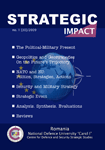THE SECURITY ENVIRONMENT WITHIN CENTRAL AND EASTERN EUROPE THROUGH THE SECURITY STRATEGIES OF ROMANIA, HUNGARY, THE CZECH REPUBLIC AND SLOVAKIA – COMPARATIVE ANALYSIS
THE SECURITY ENVIRONMENT WITHIN CENTRAL AND EASTERN EUROPE THROUGH THE SECURITY STRATEGIES OF ROMANIA, HUNGARY, THE CZECH REPUBLIC AND SLOVAKIA – COMPARATIVE ANALYSIS
Author(s): Georgeta ChirleşanSubject(s): International relations/trade, Security and defense, Military policy, Comparative politics, Peace and Conflict Studies
Published by: Carol I National Defence University Publishing House
Keywords: security strategies; regional security; Central and Eastern Europe;
Summary/Abstract: The security strategies play an important role in shaping the foreign affairs, in defining the level of interaction between different strategic actors, in understanding the security environment and especially in forecasting certain trends and evolution. Which are the national values and interests of the states, what threats, risks and challenges could exist – with afferent levels of imminence, which objectives and tasks the countries have to deal with, what are the implementation instruments they can use – all of them are elements to be comprised within a demarche of comparative analysis of the national security strategies. A comparative analysis of the security strategies of Romania, Hungary, Czech Republic and Slovakia may lead to the identification of some similarities, differences and particularities regarding their structure and content - useful elements in pointing out the way in which these national strategies are framed within the context of the European Union security strategy and within the understanding of the current regional security environment in the Central and Eastern Europe. These are few aspects we have tried to identify in the next pages.
Journal: Strategic Impact
- Issue Year: 2009
- Issue No: 30
- Page Range: 50-61
- Page Count: 12
- Language: English

